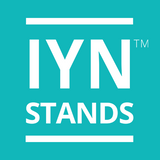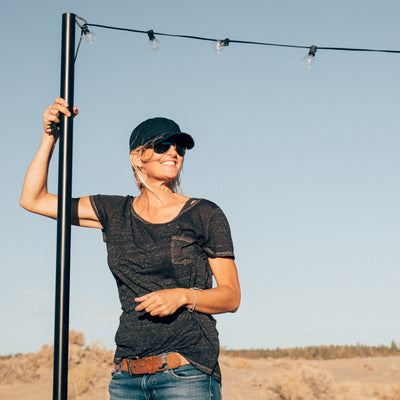String Light Pole Stand Questions and Answers
How do I determine the stand style I need?
We offer 3 pole styles: Pole Stand with Mounting Plate, Pole Stand with Tank Base and Pole Stand with Brackets
String Light Pole Stands with Tank Base are ideal for locations that don’t allow you to bolt or screw into a wooden deck, wedge anchor into concrete or stake into the grass. For example, a pavered patio area or non-wooden deck.
They are also ideal for rental companies that will set up temporary lights for events. For example, a wedding reception on a grassy area, a dance floor inside a venue or a booth at a trade show.
Tank Stands are designed for shorter runs of string lights of approximately 20 feet if using thin gauge string lights such as G40 string lights. Tank stands cannot support heavy gauge string lights as sold at Costco.
Pole Stands with Base Plate are ideal for a permanent set up where you can bolt or screw into a wooden deck or wedge anchor into concrete. They are also ideal for longer runs of string lights. They can accommodate a 30-foot span of G40 string lights.
Pole Stand with Brackets are designed to attach to fence posts, railings or concrete walls. The 9' 6" pole comes with 2 brackets that are 4.25" long and 2" deep allowing the pole to bypass a standard fence post cap or railing cap. They can accommodate a 30-foot span of G40 string lights.
How do I attach the pole stand to a wood deck?
If you can access underneath your deck click here to learn How To Install Using Bolts.
If you can NOT access underneath your deck click here to learn How to Install Using Lag Screws.
How do I install my pole stand on concrete?
Click here to learn How to Install Pole Stands on Concrete
How do I install my Pole Stand in grass, dirt or sand?
Click here for How To Install Pole Stand in Grass, Dirt or Sand
How do I install IYN Tank Stands outdoors?
For outdoor installations, you can fill the tanks with sand or water. If possible, it’s easiest to fill the tanks in their desired location. If not, you will want a hand truck or dolly to move the tanks into position once they are filled because they will weigh approximately 186 lbs. with sand and approximately 123 lbs. with water. After positioning the tanks, string the lights and secure the lights to the carabiner clips. If they lights slid inside the carabiner you can use a black zip tie of rubber twist tie to lock them in place. Click here for additional installation information.
How do I install IYN Tank Stands indoors?
For indoor installations, we recommend using sand to avoid any accidental water damage. If the use of sand is not an option then keep in mind that you might need to wheel the tanks to a water source using a hand truck or dolly. Click here for additional installation information.
How do I winterize my Tank Stands?
If you live in areas that experience freezing temperatures during the winter you will need to drain your tank if it is filled with water and store it empty. If your tank is filled with sand you can leave it up year round.
How do I install my pole with 2 brackets?
Click here for How To Install Pole With Brackets
What type of lights should I purchase?
At IYN we highly recommend using G40 Bistro Lights, as they are durable, lightweight, use plastic bulbs (that won't shatter), and are energy efficient LED. We don't recommend heavy duty string lights such as the ones sold at Costco as those types of light are 4x heavier than our G40 lights and create undo pull and wear on string light poles.
How do I secure the lights to the carabiner clips?
2 ways….black zip ties and plier cutters to cut the ends of the zip ties or 3” to 6” black reusable rubber twist ties found on Amazon, Home Depot or Lowes. We prefer the black zip ties and offer them here.
How do I eliminate the sagging of lights over long spans?
We recommend using G40 Bistro Lights as they are lighter than other types of string lights (up to 4x lighter) so they will experience less sagging. We don't suggest trying to make string lights "taut" or overly tight as it create undue strain on the string light poles. If you decide you need to have tight string lights you may need to attach to structures or trees that can support the strain.
How do I determine my string light pattern?
This step is all about evaluating your space and determining 4 things:
What area do I want to illuminate?
Are there structures or trees that I want to attach the lights to?
Where do I need to install a pole stand, tank stand or pole and brackets if I don’t have structures or trees to incorporate in my pattern?
Where is my power source?
Once you’ve answered these questions you can start your pattern at the power source. Often it will be an outlet on the side of your structure or under the eaves. You may need to run an extension cord up the structure to where the lights will begin. If you’re starting on the side of the structure you may also need to add a hook. From here you can start the lights and then create a lighting pattern that meets your needs. They string lights often look best when they are hung in a symmetrical design, they don’t need to be perfect, but it’s nice to have flow to your design. Some popular designs are a V of lights extending from the structure out to a pole stand and back to the structure, an X of lights, a W of lights, a fan of lights or a perimeter of lights.
Can I use a dimmer with my string lights?
All incandescent lights can be coupled with a dimmer and there are now some LED lights can can also be used with a dimmer. Check the specs on your LED lights.
Dimmers come in a variety of options and allow you to control the brightness of the lights. They range from $13 for use of 300 watts of lights to $47 for use with 1000 watts of lights.

